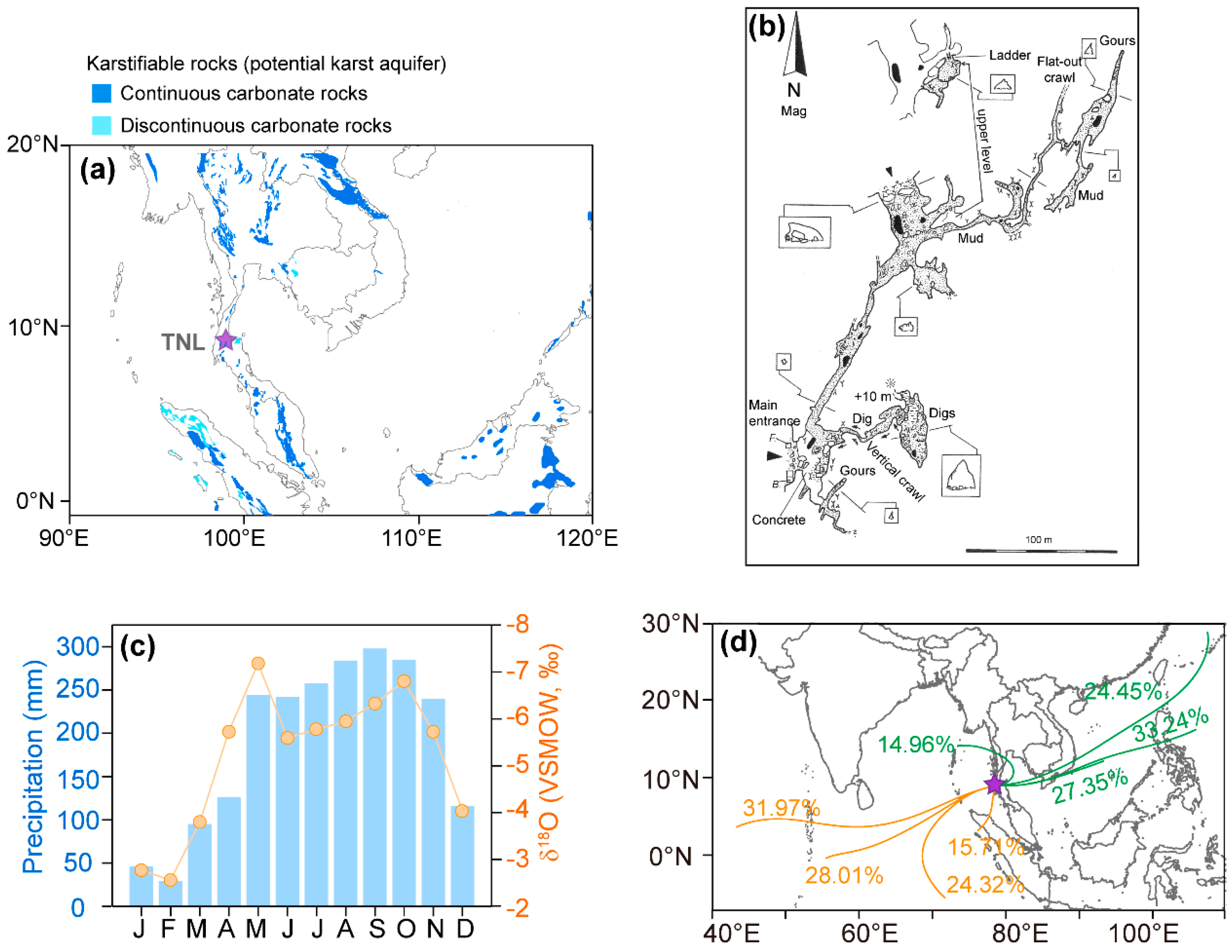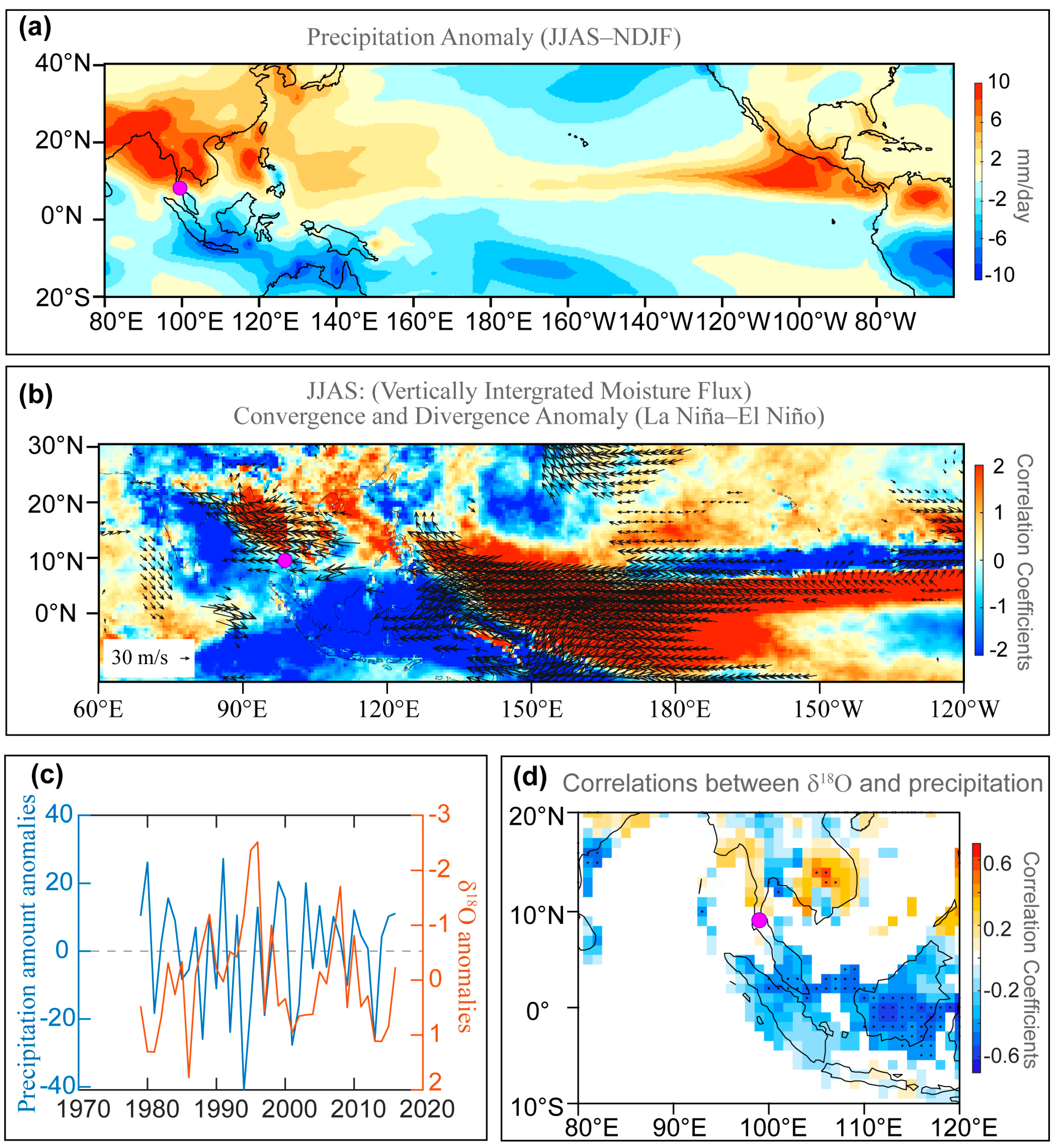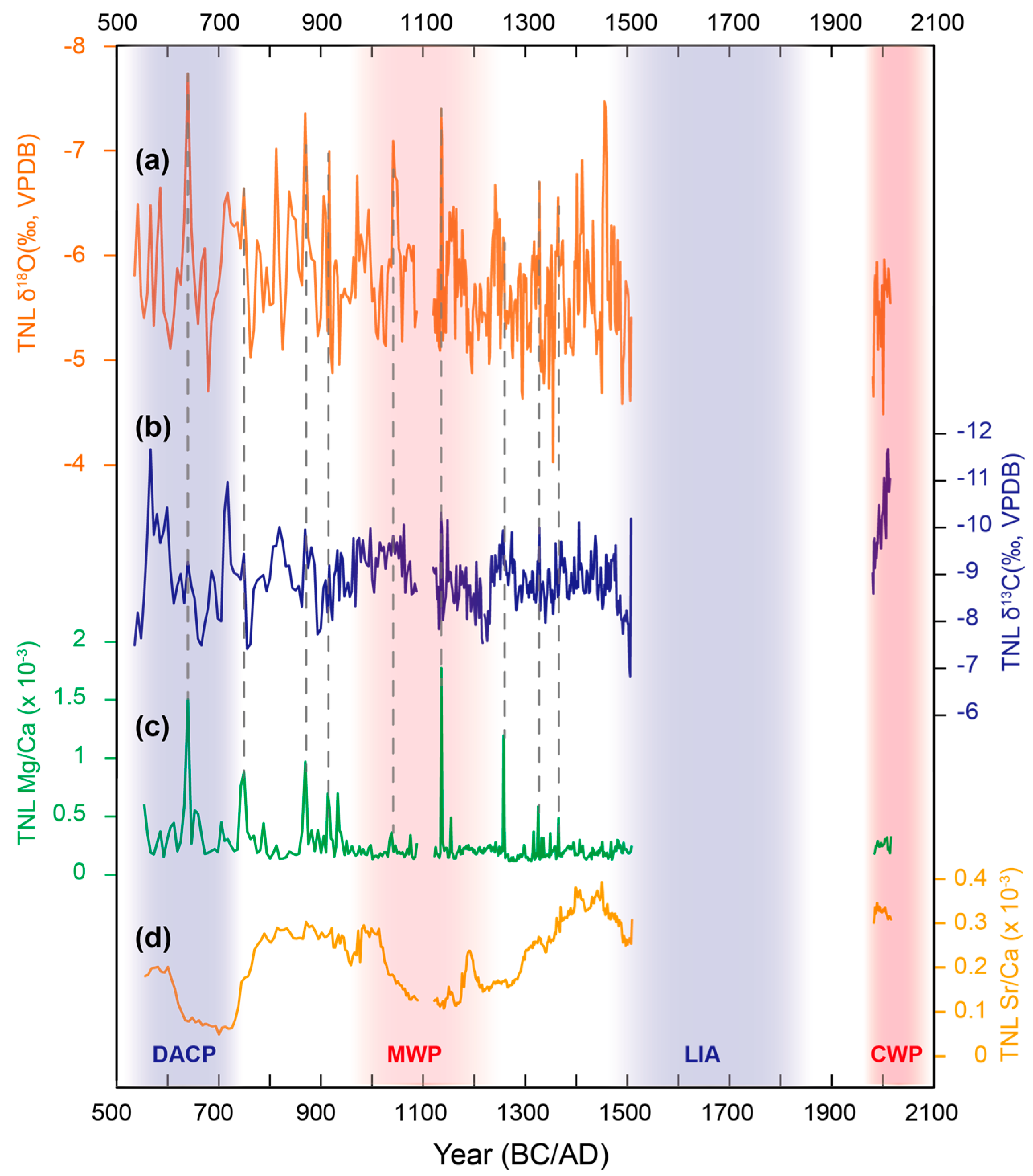Vegetation Changes and Dynamics of the Climate Variables in Southern Thailand over the Past 1500 Years
Abstract
:1. Introduction
2. Materials and Methods
2.1. Cave Sites and Sampling
2.2. 230Th Dating Method
2.3. Stable Isotope and Trace Element Analysis
3. Results
3.1. Age Models
3.2. Interpretation of the Stable Isotope Records
3.3. Interpretation of the Trace Element Records
4. Discussion
4.1. Temporospatial Patterns of Climate in Southern Thailand
4.2. Influence of the ENSO on Precipitation in Southern Thailand
4.3. Vegetation Greenness in Response to Climate Change in Southern Thailand
5. Conclusions
Supplementary Materials
Author Contributions
Funding
Data Availability Statement
Acknowledgments
Conflicts of Interest
References
- Trenberth, K.E.; Dai, A.; Van Der Schrier, G.; Jones, P.D.; Barichivich, J.; Briffa, K.R.; Sheffield, J. Global warming and changes in drought. Nat. Clim. Chang. 2014, 4, 17–22. [Google Scholar] [CrossRef]
- Monastersky, R. Anthropocene: The human age. Nature 2015, 519, 144–147. [Google Scholar] [CrossRef] [PubMed]
- Subramanian, M. Humans versus Earth: The quest to define the Anthropocene. Nature 2019, 572, 168–170. [Google Scholar] [CrossRef] [PubMed]
- Jones, P.D.; Briffa, K.R.; Osborn, T.J.; Lough, J.M.; Van Ommen, T.D.; Vinther, B.M.; Luterbacher, J.; Wahl, E.R.; Zwiers, F.W.; Mann, M.E.; et al. High-resolution palaeoclimatology of the last millennium: A review of current status and future prospects. Holocene 2009, 19, 3–49. [Google Scholar] [CrossRef]
- Loehle, C. A 2000-year global temperature reconstruction based on non-tree ring proxies. Energy Environ. 2007, 18, 1049–1058. [Google Scholar] [CrossRef]
- IPCC. Climate Change 2021: The Physical Science Basis; Cambridge University Press: Cambridge, UK; New York, NY, USA, 2021; pp. 33–144. [Google Scholar] [CrossRef]
- PAGES. Science Plan and Implementation Strategy (IGBP Report No.57); IGBP Secretariat: Stockholm, Sweden, 2009; pp. 1–67. Available online: http://www.igbp.net/publications/reportsandscienceplans/reportsandscienceplans/reportno57.5.1b8ae20512db692f2a680006621.html (accessed on 5 November 2023).
- Stone, D.A.; Allen, M.R.; Stott, P.A.; Pall, P.; Min, S.-K.; Nozawa, T.; Yukimoto, S. The detection and attribution of human influence on climate. Ann. Rev. Environ. Resoure 2009, 34, 1–16. [Google Scholar] [CrossRef]
- Sha, L.; Ait Brahim, Y.; Wassenburg, J.A.; Yin, J.; Peros, M.; Cruz, F.W.; Cai, Y.; Li, H.; Du, W.; Zhang, H.; et al. How far north did the African Monsoon fringe expand during the African Humid Period?—Insights from Southwest Moroccan speleothems. Geophys. Res. Lett. 2019, 46, 14093–14102. [Google Scholar] [CrossRef]
- Sha, L.; Ait Brahim, Y.; Wassenburg, J.A.; Yin, J.; Lu, J.; Cruz, F.W.; Cai, Y.; Edwards, R.L.; Cheng, H. The “Hockey Stick” Imprint in Northwest African Speleothems. Geophys. Res. Lett. 2021, 48, e2021GL094232. [Google Scholar] [CrossRef]
- Tan, L.; Shen, C.-C.; Löwemark, L.; Chawchai, S.; Edwards, R.L.; Cai, Y.; Breitenbach, S.F.M.; Cheng, H.; Chou, Y.-C.; Duerrast, H.; et al. Rainfall variations in central Indo-Pacific over the past 2700 y. Proc. Natl. Acad. Sci. USA 2019, 116, 17201–17206. [Google Scholar] [CrossRef]
- Yin, J.; Xu, Q.; Siripornpibul, C.; Siripattarapureenon, R.; Wu, X.; Tang, W.; Cheng, H.; Ning, Y.; Qin, Z. Hydroclimate variability in early stage of late Holocene recorded by stalagmite from Southern Thailand. Carsol. Sin. 2023, 42, 573–581. Available online: http://en.cgsjournals.com/article/doi/10.11932/karst20230307?viewType=HTML (accessed on 5 November 2023). (In Chinese).
- Cai, B.G.; Pumijumnong, N.; Tan, M. Effects of intraseasonal variation of summer monsoon rainfall on stable isotope and growth rate of a stalagmite from northwestern Thailand. J. Geophys. Res. 2010, 115, D21104. [Google Scholar] [CrossRef]
- Chawchai, S.; Chabangborn, A.; Fritz, S.; Väliranta, M.; Mörth, C.M.; Blaauw, M.; Reimer, P.J.; Krusic, P.J.; Löwemark, L.; Wohlfarth, B. Hydroclimatic shifts in Northeast Thailand during the last two millennia: The record of Lake Pa Kho. Quat. Sci. Rev. 2015, 111, 62–71. [Google Scholar] [CrossRef]
- Cheng, H.; Zhang, H.; Cai, Y.; Shi, Z.; Yi, L.; Deng, C.; Hao, Q.; Peng, Y.; Sinha, A.; Li, H.; et al. Orbital-scale Asian summer monsoon variations: Paradox and exploration. Sci. China Earth Sci. 2021, 63, 529–544. [Google Scholar] [CrossRef]
- Maxwell, J.F. A synopsis of the vegetation of Thailand. Nat. Hist. J. Chulalongkorn Univ. 2004, 4, 19–29. Available online: https://www.thaiscience.info/Journals/Article/NHCU/10439727.pdf (accessed on 10 November 2023).
- du Plessis, W.P. Linear regression relationship between NDVI vegetation and rainfall in Etosha National Park, Namibia. J. Arid Environ. 1999, 42, 235–260. [Google Scholar] [CrossRef]
- Pettorellii, N.; Vik, J.O.; Mysterud, A.; Gaillard, J.-M.; Tucker, C.J.; Stenseth, N.C. Using the satellite-derived NDVI to assess ecological response to environmental change. Trends Ecol. Evol. 2005, 20, 503–510. [Google Scholar] [CrossRef] [PubMed]
- Seneviratne, S.I.; Corti, T.; Davin, E.L.; Hirschi, M.; Jaeger, E.B.; Lehner, I.; Orlowsky, B.; Teuling, A.J. Investigating soil moisture-climate interactions in a changing climate: A review. Earth Sci. Rev. 2010, 99, 125–161. [Google Scholar] [CrossRef]
- Pielke, R.A.; Pitman, A.; Niyogi, D.; Mahmood, R.; McAlpine, C.; Hossain, F.; Goldewijk, K.K.; Nair, U.; Betts, R.; Fall, S.; et al. Land use/land cover changes and climatic: Modeling analysis and observational evidence. WIREs Clim. Chang. 2011, 2, 828–850. [Google Scholar] [CrossRef]
- Sha, L.; Wassenburg, J.A.; Sha, L.; Li, Y.; Zhou, S.; Liang, Q.; Zhao, J.; Ruan, J.; Li, H.; Zhao, X.; et al. Variations in triple oxygen isotope of speleothems from the Asian monsoon region reveal moisture sources over the past 300 years. Commun. Earth Environ. 2023, 4, 384. [Google Scholar] [CrossRef]
- Chen, Z.; Auler, A.S.; Bakalowicz, M.; Drew, D.; Griger, F.; Hartmann, J.; Jiang, G.; Moosdorf, N.; Richts, A.; Stevanovic, Z.; et al. The World Karst Aquifer Mapping project: Concept, mapping procedure and map of Europe. Hydrogeol. J. 2017, 25, 771–785. [Google Scholar] [CrossRef]
- Kalnay, E.; Kanamitsu, M.; Kistler, R.; Collins, W.; Deaven, D.; Gandin, L.; Iredell, M.; Saha, S.; White, G.; Woollen, J.; et al. The NCEP/NCAR 40-Year Reanalysis Project. Bull. Am. Meteorol. Soc. 1996, 77, 437–471. [Google Scholar] [CrossRef]
- Edwards, R.L.; Chen, J.H.; Wasserburg, G.J. 238U, 234U, 230Th, 232Th systematics and the precise measurement of time over the past 500,000 years. Earth Planet. Sci. Lett. 1987, 81, 175–192. [Google Scholar] [CrossRef]
- Cheng, H.; Edwards, R.L.; Shen, C.-C.; Polyak, V.J.; Asmerom, Y.; Woodhead, J.; Hellstrom, J.; Alexander, E.C., Jr. Improvements in 230Th dating, 230Th and 234U half-life values, and U–Th isotopic measurements by multi-collector inductively coupled plasma mass spectrometry. Earth Planet. Sci. Lett. 2013, 371–372, 82–91. [Google Scholar] [CrossRef]
- Hercman, H.; Pawlak, J. MOD-AGE: An age-depth model construction algorithm. Quat. Geochronol. 2012, 12, 1–10. [Google Scholar] [CrossRef]
- Breitenbach, S.F.M.; Rehfeld, K.; Goswami, B.; Baldini, J.U.L.; Ridley, H.E.; Kennett, D.J. Constructing Proxy Records from Age models (COPRA). Clim. Past. 2012, 8, 1765–1779. [Google Scholar] [CrossRef]
- Scholz, D.; Hoffmann, D.L. StalAge—An algorithm designed for construction of speleothem age models. Quat. Int. 2011, 6, 369–382. [Google Scholar] [CrossRef]
- Wei, Z.; Lee, X.; Liu, Z.; Seeboonruang, U.; Koike, M.; Yoshimura, K. Influences of large-scale convection and moisture source on monthly precipitation isotope ratios observed in Thailand, Southeast Asia. Earth Planet. Sci. Lett. 2018, 488, 181–192. [Google Scholar] [CrossRef]
- Adler, R.F.; Huffman, G.J.; Chang, A.; Ferraro, R.; Xie, P.-P.; Janowiak, J.; Rudolf, B.; Schneider, U.; Curtis, S.; Bolvin, D.; et al. The version 2 Global Precipitation Climatology Project (GPCP) Monthly Precipitation Analysis (1979-present). J. Hydrometeor. 2003, 4, 1147–1167. [Google Scholar] [CrossRef]
- Fohlmeister, J.; Voarintsoa, N.R.G.; Lechleitner, F.A.; Boyd, M.; Brandtsta¨tter, S.; Jacobson, M.J.; Oster, J.L. Main controls on the stable carbon isotope composition of speleothems. Geochim. Cosmochim. Acta. 2020, 279, 67–87. [Google Scholar] [CrossRef]
- Martín-Chivelet, J.; Muñoz-García, M.B.; Edwards, R.L.; Turrero, M.J.; Ortega, A.I. Land surface temperature changes in Northern Iberia since 4000 yr BP, based on δ13C of speleothems. Glob. Planet. Chang. 2011, 77, 1–12. [Google Scholar] [CrossRef]
- Dorale, J.A.; Edwards, R.L.; Ito, E.; González, L.A. Climate and Vegetation History of the Midcontinent from 75 to 25 ka: A Speleothem Record from Crevice Cave, Missouri, USA. Science 1998, 282, 1871–1874. [Google Scholar] [CrossRef] [PubMed]
- McDermott, F. Palaeo-climate reconstruction from stable isotope variations in speleothems: A review. Quat. Sci. Rev. 2004, 23, 901–918. [Google Scholar] [CrossRef]
- Johnson, K.R.; Hu, C.Y.; Belshaw, N.S.; Henderson, G.M. Seasonal trace-element and stable-isotope variations in a Chinese speleothem: The potential for high- resolution paleomonsoon reconstruction. Earth Planet. Sci. Lett. 2006, 244, 394–407. [Google Scholar] [CrossRef]
- Hansen, M.; Scholz, d.; Schöne, B.R.; Spötl, C. Simulating speleothem growth in the laboratory: Determination of the stable isotope fractionation (δ13C and δ18O) between H2O, DIC and CaCO3. Chem. Geol. 2019, 509, 20–44. [Google Scholar] [CrossRef]
- Owen, R.A.; Day, C.C.; Hu, C.-Y.; Liu, Y.-H.; Pointing, M.D.; Blättler, C.L.; Henderson, G.M. Calcium isotopes in caves as a proxy for aridity: Modern calibration and application to the 8.2 kyr event. Earth Planet. Sci. Lett. 2016, 443, 129–138. [Google Scholar] [CrossRef]
- McDonald, J.; Drysdale, R.; Hill, D.; Chisari, R.; Wong, H. The hydrochemical response of cave drip waters to sub-annual and inter-annual climate variability, Wombeyan Caves, SE Australia. Chem. Geol. 2007, 244, 605–623. [Google Scholar] [CrossRef]
- Oster, J.L.; Montañez, I.P.; Kelley, N.P. Response of a modern cave system to large seasonal precipitation variability. Geochim. Cosmochim. Acta 2012, 91, 92–108. [Google Scholar] [CrossRef]
- Zhang, J.; Li, T.-Y. Seasonal and interannual variations of hydrochemical characteristics and stable isotopic compositions of drip waters in Furong Cave, Southwest China based on 12 years’ monitoring. J. Hydrol. 2019, 572, 40–50. [Google Scholar] [CrossRef]
- McMillan, M.R.; Fairchild, I.J. An experimental study of incongruent dissolution of CaCO3 under analogue glacial conditions. J. Glaciol. 2005, 51, 383–390. [Google Scholar] [CrossRef]
- Fairchild, I.J.; Borsato, A.; Tooth, A.F.; Frisia, S.; Hawkesworth, C.J.; Huang, Y.M.; McDermott, F.; Spiro, B. Controls on trace element (Sr–Mg) compositions of carbonate cave waters: Implications for speleothem climatic records. Chem. Geol. 2000, 166, 255–269. [Google Scholar] [CrossRef]
- Fairchild, I.J.; Treble, P.C. Trace elements in speleothems as recorders of environmental change. Quat. Sci. Rev. 2009, 28, 449–468. [Google Scholar] [CrossRef]
- Stríkis, N.M.; Buarque, P.F.S.M.; Cruz, F.W.; Bernal, J.P.; Vuille, M.; Tejedor, E.; Santos, S.; Shimizu, M.H.; Ampuero, A.; Du, W.; et al. Modern anthropogenic drought in Central Brazil unprecedented during last 700 years. Nat. Commun. 2024, 15, 1728. [Google Scholar] [CrossRef] [PubMed]
- Lyu, Y.; Luo, W.; Wang, Y.; Zeng, G.; Chen, J.; Wang, S. Response of drip water Mg/Ca and Sr/Ca variations in ventilated caves to hydroclimate. Sci. Total Environ. 2023, 874, 162626. [Google Scholar] [CrossRef] [PubMed]
- Hashim, M.S.; Kaczmarek, S.E. The transformation of aragonite to calcite in the presence of magnesium: Implications for marine diagenesis. Earth Planet. Sci. Lett. 2021, 574, 117166. [Google Scholar] [CrossRef]
- Li, J.-Y.; Li, T.-Y.; Shen, C.-C.; Yu, T.-L.; Zhang, T.-T.; Wu, Y.; Zhou, J.-L.; Chen, C.-J.; Zhang, J. Variations and significance of Mg/Sr and 87Sr/86Sr in a karst cave system in southwest China. J. Hydrol. 2021, 596, 126140. [Google Scholar] [CrossRef]
- Day, C.C.; Henderson, G.M. Controls on trace-element partitioning in cave-analogue calcite. Geochim. Cosmochim. Acta 2013, 120, 612–627. [Google Scholar] [CrossRef]
- Gabitov, R.I.; Sadekov, A.; Leinweber, A. Crystal growth rate effect on Mg/Ca and Sr/ Ca partitioning between calcite and fluid: An in situ approach. Chem. Geol. 2014, 367, 70–82. [Google Scholar] [CrossRef]
- Wittenberg, A.T.; Rosati, A.; Delworth, T.L.; Vecchi, G.A.; Zeng, F. ENSO Modulation: Is It Decadally Predictable? J. Clim. 2014, 27, 2667–2681. [Google Scholar] [CrossRef]
- DiNezio, P. A high bar for decadal forecasts of El Niño. Nature 2014, 507, 437–439. [Google Scholar] [CrossRef]
- Li, J.; Xie, S.-P.; Cook, E.R.; Huang, G.; D’Arrigo, R.; Liu, F.; Ma, J.; Zheng, X.-T. Interdecadal modulation of El Niño amplitude during the past millennium. Nat. Clim. Chang. 2011, 1, 114–118. [Google Scholar] [CrossRef]
- Muangsong, C.; Cai, B.; Pumijumnong, N.; Hu, C.; Cheng, H. An annually laminated stalagmite record of the changes in Thailand monsoon rainfall over the past 387 years and its relationship to IOD and ENSO. Quat. Int. 2014, 349, 90–97. [Google Scholar] [CrossRef]
- Tierney, J.E.; Abram, N.J.; Anchukaitis, K.J.; Evans, M.N.; Giry, C.; Kilbourne, K.H.; Saenger, C.P.; Wu, H.C.; Zinke, J. Tropical sea surface temperatures for the past four centuries reconstructed from coral archives. Paleoceanography 2015, 30, 226–252. [Google Scholar] [CrossRef]
- Chen, H.S.; Qian, M.Y.; Hua, W.J. Vegetation cover change in the Indo-China Peninsula in spring and its relation to ENSO. Trans. Atmos. Sci. 2020, 43, 1065–1075. [Google Scholar] [CrossRef]
- Heaney, L.R. A Synopsis of Climatic and Vegetational Change in Southeast Asia. Clim Chang. 1991, 19, 53–61. [Google Scholar] [CrossRef]
- Stibig, H.-J.; Achard, F.; Carboni, S.; Raši, R.; Miettinen, J. Change in tropical forest cover of Southeast Asia from 1990 to 2010. Biogeosciences 2014, 11, 47–258. [Google Scholar] [CrossRef]
- Thavorntam, W.; Tantemsapya, N. Vegetation greenness modeling in response to climate change for Northeast Thailand. J. Geogr. Sci. 2013, 23, 1052–1068. [Google Scholar] [CrossRef]
- Lawrence, D.; Vandecar, K. Effects of tropical deforestation on climate and agriculture. Nat. Clim. Chang. 2015, 5, 27–36. [Google Scholar] [CrossRef]
- Liang, Z.M.; Li, M.; Yang, B.J. Ancient History of Southeast Asia—Upper Antiquity to the Early 16th Century; Peking University Press: Beijing, China, 2013; pp. 289–312. [Google Scholar]
- IPCC. Climate Change 2007: The Physical Science Basis; Cambridge University Press: Cambridge, UK; New York, NY, USA, 2007; pp. 21–64. Available online: https://www.ipcc.ch/report/ar4/wg1/ (accessed on 15 November 2023).
- Buckley, B.M.; Palakit, K.; Duangsathaporn, K.; Sanguantham, P.; Prasomsin, P. Decadal scale droughts over northwestern Thailand over the past 448 years: Links to the tropical Pacific and Indian Ocean sectors. Clim. Dyn. 2007, 29, 63–71. [Google Scholar] [CrossRef]





Disclaimer/Publisher’s Note: The statements, opinions and data contained in all publications are solely those of the individual author(s) and contributor(s) and not of MDPI and/or the editor(s). MDPI and/or the editor(s) disclaim responsibility for any injury to people or property resulting from any ideas, methods, instructions or products referred to in the content. |
© 2024 by the authors. Licensee MDPI, Basel, Switzerland. This article is an open access article distributed under the terms and conditions of the Creative Commons Attribution (CC BY) license (https://creativecommons.org/licenses/by/4.0/).
Share and Cite
Wang, J.; Sha, L.; He, J.; Zhao, X.; Zhang, R.; Yang, B.; Cheng, H. Vegetation Changes and Dynamics of the Climate Variables in Southern Thailand over the Past 1500 Years. Minerals 2024, 14, 519. https://doi.org/10.3390/min14050519
Wang J, Sha L, He J, Zhao X, Zhang R, Yang B, Cheng H. Vegetation Changes and Dynamics of the Climate Variables in Southern Thailand over the Past 1500 Years. Minerals. 2024; 14(5):519. https://doi.org/10.3390/min14050519
Chicago/Turabian StyleWang, Jian, Lijuan Sha, Jin He, Xinnan Zhao, Rui Zhang, Baojun Yang, and Hai Cheng. 2024. "Vegetation Changes and Dynamics of the Climate Variables in Southern Thailand over the Past 1500 Years" Minerals 14, no. 5: 519. https://doi.org/10.3390/min14050519
APA StyleWang, J., Sha, L., He, J., Zhao, X., Zhang, R., Yang, B., & Cheng, H. (2024). Vegetation Changes and Dynamics of the Climate Variables in Southern Thailand over the Past 1500 Years. Minerals, 14(5), 519. https://doi.org/10.3390/min14050519




